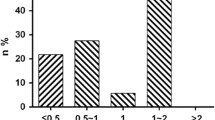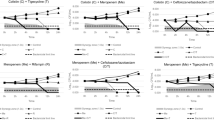Abstract
The rates of urinary tract infection with multidrug-resistant (MDR) Escherichia coli have dramatically increased and the treatment of these infections with single and double antibiotic combinations became limited or ineffective. The present study aimed at finding effective antibiotic combinations against MDR uropathogenic E. coli. Antibiotic susceptibility testing of uropathogenic E. coli isolates (n = 29) showed that all the examined isolates were found to be MDR. The interaction of double and triple combinations of fosfomycin (FOS) with imipenem (IPM), ciprofloxacin (CIP) and tobramycin (TOB) against selected isolates (n = 8) by checkerboard method showed that all the examined combinations exhibited synergistic effects (FIC index < 1) against tested isolate. However, 1/8, 5/8 and 6/8 of the isolates remained resistant to the constituent antibiotics in FOS/IPM, FOS/CIP and FOS/TOB combinations, respectively. Notably, the triple combinations (FOS/IPM/CIP, FOS/IPM/TOB and FOS/CIP/TOB) increased the synergism against all selected isolates at MIC levels lower than the susceptible breakpoints. Furthermore, time-kill analysis demonstrated that FOS/IPM combination exhibited synergistic and bactericidal effects with UTI-9. However, the combination had no effect on UTI-13. The highest synergistic and bactericidal effects against both representative isolates were achieved by FOS/IPM/CIP, FOS/IPM/TOB and FOS/CIP/TOB combinations after 2 h of post-treatment and lasted up to 24 h. Therefore, we report here that the combinations of FOS with IPM, CIP and TOB could be beneficial against MDR uropathogenic E. coli at least in vitro. The effectiveness of these antibiotics increased in combination with FOS compared to individual antibiotics acting alone.
Similar content being viewed by others
References
Stamm WE, Norrby SR (2002) Urinary tract infections: disease panorama and challenges. J Infect Dis 183:S1–S4. https://doi.org/10.1086/318850
Mohamed NR, Omar HHH, Abd-Allah IM (2017) Prevalence and risk factors of urinary tract infection among pregnant women in Ismailia City Egypt. IOSR J Nurs Health Sci 06:62–72. https://doi.org/10.9790/1959-0603076272
El-Kashif MML, Eaid Elgazzar S (2018) Maternal markers for detecting urinary tract infection among pregnant women in Port Said City Egypt. Am J Nurs Res 6:317–326. https://doi.org/10.12691/ajnr-6-5-14
Ejrnæs K (2011) Bacterial characteristics of importance for recurrent urinary tract infections caused by Escherichia coli. Dan Med Bull 58:B4187
Ramírez-Castillo FY, Moreno-Flores AC, Avelar-González FJ et al (2018) An evaluation of multidrug-resistant Escherichia coli isolates in urinary tract infections from Aguascalientes, Mexico: cross-sectional study. Ann Clin Microbiol Antimicrob 17:34. https://doi.org/10.1186/s12941-018-0286-5
Tängdén T (2014) Combination antibiotic therapy for multidrug-resistant Gram-negative bacteria. Ups J Med Sci 119:149–153. https://doi.org/10.3109/03009734.2014.899279
Reffert JL, Smith WJ (2014) Fosfomycin for the treatment of resistant gram-negative bacterial infections: insights from the society of infectious diseases pharmacists. Pharmacotherapy 34:845–857. https://doi.org/10.1002/phar.1434
Yaneja N, Kaur H (2016) Insights into newer antimicrobial agents against gram-negative bacteria. Microbiol Insights 9:MBI.S29459. https://doi.org/10.4137/mbi.s29459
Berleur M, Guérin F, Massias L et al (2018) Activity of fosfomycin alone or combined with temocillin in vitro and in a murine model of peritonitis due to KPC-3- or OXA-48-producing Escherichia coli. J Antimicrob Chemother 73:3074–3080. https://doi.org/10.1093/jac/dky283
Bilal H, Peleg AY, McIntosh MP et al (2018) Elucidation of the pharmacokinetic/pharmacodynamic determinants of fosfomycin activity against Pseudomonas aeruginosa using a dynamic in vitro model. J Antimicrob Chemother 73:1570–1578. https://doi.org/10.1093/jac/dky045
Rustini R, Jamsari J, Marlina M et al (2017) Antibacterial resistance pattern of Pseudomonas aeruginosa isolated from clinical samples at a General Hospital in Padang, West Sumatra, Indonesia. Asian J Pharm Clin Res 7:240–244
CLSI (2012) Methods for dilution antimicrobial susceptibility tests for bacteria that grow aerobically. Approved Standard-Ninth Edition. CLSI document M07-A9. 32:92
White RL, Burgess DS, Manduru M, Bosso JA (1996) Comparison of three different in vitro methods of detecting synergy: time-kill, checkerboard, and E test. Antimicrob Agents Chemother 40:1914–1918
Giske CG, Martinez-Martinez L, Cantón R, et al (2013) EUCAST guidelines for detection of resistance mechanisms and specific resistances of clinical and/or epidemiological importance, pp 1–40
Berenbaum MC (2018) A method for testing for synergy with any number of agents. 137:122–130
Yu VL, Felegie TP, Yee RB et al (1980) Synergistic interaction in vitro with use of three antibiotics simultaneously against pseudomonas maltophilia. J Infect Dis 142:602–607. https://doi.org/10.1093/infdis/142.4.602
Laxminarayan R, Duse A, Wattal C et al (2013) Antibiotic resistance-the need for global solutions. Lancet Infect Dis 13:1057–1098. https://doi.org/10.1016/S1473-3099(13)70318-9
Paphitou NI (2013) Antimicrobial resistance: action to combat the rising microbial challenges. Int J Antimicrob Agents 42:S25–S28. https://doi.org/10.1016/J.IJANTIMICAG.2013.04.007
Agyepong N, Govinden U, Owusu-Ofori A, Essack SY (2018) Multidrug-resistant gram-negative bacterial infections in a teaching hospital in Ghana. Antimicrob Resist Infect Control 7:37. https://doi.org/10.1186/s13756-018-0324-2
Odoki M, Aliero AA, Tibyangye J et al (2019) Prevalence of bacterial urinary tract infections and associated factors among patients attending hospitals in Bushenyi District Uganda. Int J Microbiol. https://doi.org/10.1155/2019/4246780
Zhanel GG, Zhanel MA, Karlowsky JA (2018) Intravenous fosfomycin: an assessment of its potential for use in the treatment of systemic infections in Canada. Can J Infect Dis Med Microbiol 2018:1–13. https://doi.org/10.1155/2018/8912039
Dijkmans AC, Zacarías NVO, Burggraaf J et al (2017) Fosfomycin: pharmacological clinical and future perspectives. Antibiotics 6:24. https://doi.org/10.3390/antibiotics6040024
Yanagida C, Ito K, Komiya I, Horie T (2004) Protective effect of fosfomycin on gentamicin-induced lipid peroxidation of rat renal tissue. Chem Biol Interact 148:139–147. https://doi.org/10.1016/j.cbi.2004.05.005
Al-Aloul M, Miller H, Alapati S et al (2005) Renal impairment in cystic fibrosis patients due to repeated intravenous aminoglycoside use. Pediatr Pulmonol 39:15–20. https://doi.org/10.1002/ppul.20138
Samonis G, Maraki S, Karageorgopoulos DE et al (2012) Synergy of fosfomycin with carbapenems, colistin, netilmicin, and tigecycline against multidrug-resistant Klebsiella pneumoniae, Escherichia coli, and Pseudomonas aeruginosa clinical isolates. Eur J Clin Microbiol Infect Dis 31:695–701. https://doi.org/10.1007/s10096-011-1360-5
Evren E, Azap ÖK, Çolakoǧlu Ş, Arslan H (2013) In vitro activity of fosfomycin in combination with imipenem, meropenem, colistin and tigecycline against OXA 48-positive Klebsiella pneumoniae strains. Diagn Microbiol Infect Dis 76:335–338. https://doi.org/10.1016/j.diagmicrobio.2013.04.004
Yu W, Shen P, Bao Z et al (2017) In vitro antibacterial activity of fosfomycin combined with other antimicrobials against KPC-producing Klebsiella pneumoniae. Int J Antimicrob Agents 50:237–241. https://doi.org/10.1016/j.ijantimicag.2017.03.011
Tessier F, Quentin C (1997) In vitro activity of fosfomycin combined with ceftazidime, imipenem, amikacin, and ciprofloxacin against Pseudomonas aeruginosa. Eur J Clin Microbiol Infect Dis 16:159–162. https://doi.org/10.1007/BF01709477
Walsh CC, Landersdorfer CB, McIntosh MP et al (2016) Clinically relevant concentrations of fosfomycin combined with polymyxin B, tobramycin or ciprofloxacin enhance bacterial killing of Pseudomonas aeruginosa, but do not suppress the emergence of fosfomycin resistance. J Antimicrob Chemother 71:2218–2229. https://doi.org/10.1093/jac/dkw115
Tam VH, Schilling AN, Nikolaou M (2005) Modelling time-kill studies to discern the pharmacodynamics of meropenem. J Antimicrob Chemother 55:699–706. https://doi.org/10.1093/jac/dki086
Belley A, Neesham-Grenon E, Arhin FF et al (2008) Assessment by time-kill methodology of the synergistic effects of oritavancin in combination with other antimicrobial agents against Staphylococcus aureus. Antimicrob Agents Chemother 52:3820–3822. https://doi.org/10.1128/AAC.00361-08
Sim JH, Jamaludin NS, Khoo CH et al (2014) In vitro antibacterial and time-kill evaluation of phosphanegold(I) dithiocarbamates, R3PAu[S2CN(iPr)CH2CH2OH] for R = Ph, Cy and Et, against a broad range of Gram-positive and Gram-negative bacteria. Gold Bull 47:225–236. https://doi.org/10.1007/s13404-014-0144-y
Grégoire N, Raherison S, Grignon C et al (2010) Semimechanistic pharmacokinetic-pharmacodynamic model with adaptation development for time-kill experiments of ciprofloxacin against Pseudomonas aeruginosa. Antimicrob Agents Chemother 54:2379–2384. https://doi.org/10.1128/AAC.01478-08
Haagensen J, Verotta D, Huang L et al (2017) Spatiotemporal pharmacodynamics of meropenem- and tobramycin-treated Pseudomonas aeruginosa biofilms. J Antimicrob Chemother 72:3357–3365. https://doi.org/10.1093/jac/dkx288
Eliopoulos GM, Moellering RC Jr (1982) Antibiotic synergism and antimicrobial combinations in Clinica. Rev Infect Dis 4:282–293
Skarzynski T, Mistry A, Wonacott A et al (1996) Structure of UDP-N-acetylglucosamine enolpyruvyl transferase, an enzyme essential for the synthesis of bacterial peptidoglycan, complexed with substrate UDP-N-acetylglucosamine and the drug fosfomycin. Structure 4:1465–1474. https://doi.org/10.1016/S0969-2126(96)00153-0
Bensen DC, Rodriguez S, Nix J et al (2012) Structure of MurA (UDP-N-acetylglucosamine enolpyruvyl transferase) from Vibrio fischeri in complex with substrate UDP-N-acetylglucosamine and the drug fosfomycin. Acta Crystallogr Sect F 68:382–385. https://doi.org/10.1107/S1744309112006720
MacLeod DL, Barker LM, Sutherland JL et al (2009) Antibacterial activities of a fosfomycin/tobramycin combination: a novel inhaled antibiotic for bronchiectasis. J Antimicrob Chemother 64:829–836. https://doi.org/10.1093/jac/dkp282
MacLeod DL, Velayudhan J, Kenney TF et al (2012) Fosfomycin enhances the active transport of tobramycin in Pseudomonas aeruginosa. Antimicrob Agents Chemother 56:1529–1538. https://doi.org/10.1128/aac.05958-11
Nickel JC, Kumon H, Ono N, Iida M (1995) Combination effect of fosfomycin and ofloxacin against Pseudomonas aeruginosa growing in a biofilm. Antimicrob Agents Chemother 39:1038–1044
Monden K, Ando E, Iida M, Kumon H (2002) Role of fosfomycin in a synergistic combination with ofloxacin against Pseudomonas aeruginosa growing in a biofilm. J Infect Chemother 8:218–226. https://doi.org/10.1007/s10156-002-0186-6
Okazaki M, Suzuki K, Asano N et al (2002) Effectiveness of fosfomycin combined with other antimicrobial agents against multidrug-resistant Pseudomonas aeruginosa isolates using the efficacy time index assay. J Infect Chemother 8:37–42. https://doi.org/10.1007/s101560200004
Yamada S, Hyo Y, Ohmori S, Ohuchi M (2007) Role of ciprofloxacin in its synergistic effect with fosfomycin on drug-resistant strains of Pseudomonas aeruginosa. Chemotherapy 53:202–209. https://doi.org/10.1159/000100811
Funding
This study was not funded.
Author information
Authors and Affiliations
Corresponding author
Ethics declarations
Conflict of interest
The authors declare that they have no conflict of interest.
Additional information
Publisher's Note
Springer Nature remains neutral with regard to jurisdictional claims in published maps and institutional affiliations.
Rights and permissions
About this article
Cite this article
El-Wafa, W.M.A., Ibrahim, Y.M. In Vitro Activity of Fosfomycin in Double and Triple Combinations with Imipenem, Ciprofloxacin and Tobramycin Against Multidrug-Resistant Escherichia coli. Curr Microbiol 77, 755–761 (2020). https://doi.org/10.1007/s00284-019-01871-w
Received:
Accepted:
Published:
Issue Date:
DOI: https://doi.org/10.1007/s00284-019-01871-w




